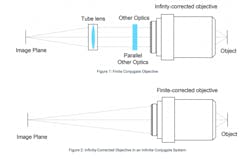Selecting the appropriate microscope for your intended application is a significant decision that demands a thorough understanding of the task at hand and the available tools. This guide aims to facilitate an informed decision-making process by introducing various types of microscopes and discussing crucial factors to consider.
Understanding Microscope Types
- Compound Microscopes: Compound microscopes use multiple lenses for high magnification (40x to 1000x) and offer advanced imaging techniques like phase contrast. They come with monocular, binocular, or trinocular heads and are suitable for thin or transparent specimens.
- Stereo Microscopes: Stereo microscopes, also known as dissecting microscopes, provide three-dimensional views of specimens. They offer lower magnification (10x to 50x), long working distances, wide fields of view, and versatile illumination for tasks like dissection or circuit board work.
- Measuring Microscopes: Designed for precise measurements, these microscopes are valuable in industries requiring high precision, such as electronics and metallurgy. They offer accurate measurements in two and three dimensions, along with advanced imaging and digital capabilities.
- Digital Microscopes: Digital microscopes integrate modern microscopy with digital technology, allowing easy viewing, analysis, and sharing of microscopic images. They enable real-time collaboration, image analysis, and enhanced visualization through features like zoom and brightness adjustments.
Choosing the Right Microscope Objective
- Magnification Matters: Consider the magnification range (4X to 100X) based on your application. Higher magnification objectives offer greater resolution but a smaller field of view, while lower magnification objectives provide a larger field of view.
- Selecting the Right Immersion Medium: Choose between dry and immersion objectives based on the need for a liquid medium between the specimen and the objective lens. Immersion objectives, using liquids like oil, provide higher NA and resolution.
- The Crucial Conjugate Distance: Understanding the conjugate distance is vital when selecting microscope objectives. Finite conjugate objectives are cost-effective for simple microscopy systems, while infinite-corrected objectives are ideal for research-grade applications requiring additional components.
- The Significance of Numerical Aperture (NA): Numerical Aperture (NA) is a crucial parameter determining a microscope objective’s light-gathering capacity and resolution. A higher NA results in superior resolution, allowing for finer image distinctions.
- Aberration Correction for Optical Precision: Consider the degree of optical aberration correction when selecting an objective lens. Achromat, Plan Achromat, Plan Apochromat, and Super Apochromat objectives offer varying levels of correction for different applications and budgets.
- The Crucial Working Distance: Working distance (WD) is the distance from the objective’s front lens to the focused object. Select objectives with appropriate working distances based on your application, especially for tasks requiring object placement within a chamber.
In conclusion, microscopy systems find diverse applications in scientific research, industry, and laboratories. The objective lens is a critical component, and choosing the right one involves considering factors such as conjugate distance, numerical aperture, magnification, working distance, immersion medium, and aberration correction. At Shanghai Optics, we offer a range of microscope solutions to meet various needs, ensuring optimal performance and image quality.
For any inquiries, please feel free to contact us, and we’ll be delighted to assist you.

